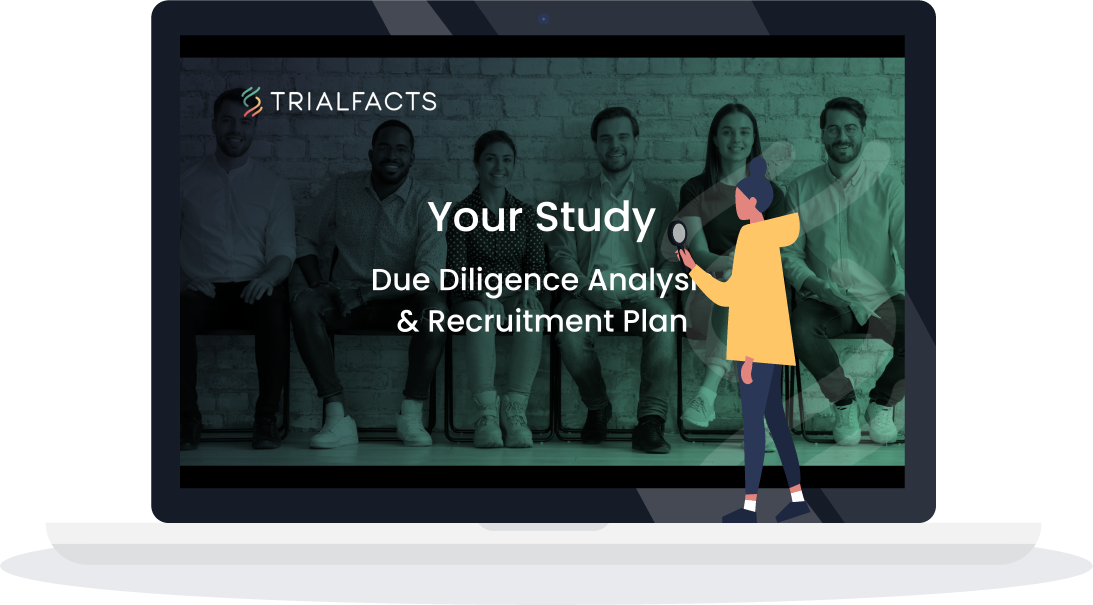If you are ready to see how many participants we can guarantee for your study, request your free, no-obligation recruitment plan today. Click the button below and fill out the 30 second form to get started.

How do you successfully recruit a study that requires hundreds of patients to be screened to meet your enrollment target, with just a small team?
Successful patient recruitment often depends on turning hundreds of inquiries into a handful of qualified candidates – a process that requires both efficiency and a personal touch.
With support, one clinical trial succeeded in narrowing a field of 500 patients into a pool of highly qualified candidates a fraction of that size.
The Exercise and Nutrition Research Program at the Australian Catholic University faced the unique challenge of recruiting and retaining two dozen participants for a study focused on Type 2 diabetes – a notoriously difficult condition to recruit for, given the condition’s many interactions and comorbidities.
The ACU study was aimed at participants aged 35-75 with a Type 2 diabetes diagnosis – who were also able to attend lab requirements, consume standardized meals and provide blood samples for analysis.
“I think it could help to change our perception of carbohydrates, particularly for people with Type 2 diabetes,” Bridget Radford, a Research Assistant and Nutritionist at the Mary MacKillop Institute for Health Research, said of the study.
With the findings, the researchers hoped to encourage people “with Type 2 diabetes to shift the focus from excluding particular foods to changing how foods are prepared or incorporated in a meal. Thus, broadening food choices and changing how carbohydrate dense foods are perceived.”
But first, they had to find participants. “It’s quite hard to find people who have Type 2 diabetes within our BMI range who don’t take any other medications apart from metformin for their diabetes,” Bridget said. The difficulty didn’t stop there: “The people who we did find who met our inclusion criteria needed to be interested and available to attend the lab for the visits required.” Other exclusion criteria included everything from having a “very active lifestyle” to having “strict dietary requirements.”
The criteria would quickly narrow the field of candidates, as the screening process to find both qualified and committed participants turned 500 initial inquiries into just 59 qualified candidates. Our interview with Bridget revealed why this was beneficial for this research and what the key factors were that played into successful patient recruitment and retention: effective prescreening tools to qualify candidates and ongoing engagement with Trialfacts throughout the process.
Knowing these challenges were ahead, the research team had Trialfacts in mind from the very beginning. Having successfully recruited patients for several of their clinical trials in the past, Trialfacts is now factored into their budgets.
This starts with Trialfacts completing a Due Diligence process to create a Recruitment Plan — a process that determines how many participants we can guarantee for a particular study. The process is free and there’s no obligation to move forward afterwards. Start the process here.
The key to recruiting the target number of participants was to start with a large pool of candidates and put them through a detailed prescreening process. You can see how this took shape in the enrollment funnel below.

The first two numbers in the graph below highlight the importance of an effective prescreening process: 484 people participated in the prescreening questionnaire, and 425 were excluded as ineligible.

Just 12 percent of those who went through prescreening passed the questionnaire, meaning they met the eligibility requirements and could commit to the study. It was this process that left the research team with a qualified shortlist of candidates by only the second stage in the enrollment funnel.
The alternative to this narrowed pool is a near impossible task for research teams with limited time, funding and resources. “One of our struggles might have been that, without having people pre-screened, they see an advertisement then ring up and we’d very quickly discover they were not eligible,” Bridget said.
Contacting everyone who responded to initial ads would have been an “impossible investment of our time,” Bridget said. Instead of interacting with nearly 500 prospective participants, the ACU research team was left with follow up for just 59 people in the form of a secondary phone screening.
From the second stage of the recruitment process onward, the statistics go up dramatically:
These percentages surpassed the projected statistics from the Trialfacts due diligence process, for an overall enrollment rate of 39 percent.
The second key determinant of success was ongoing engagement with the prescreening process. With successful patient recruitment and retention in mind, the teams from ACU and Trialfacts worked together to make the qualification process as clear as possible for participants.
Bridget spoke to how Trialfacts sets itself apart with its love of feedback and data.
“Trialfacts loves feedback. They seem to value your input, and the team seems to really want to improve their strategies to make them work best for researchers and understand the challenges.”
The researchers also valued the responsiveness of Trialfacts, such as the rephrasing of questions for participants to better understand them and the research team’s ability to pause a campaign.
Pausing a campaign was useful in the case of communicating back with potential participants and winning them as high quality participants. Bridget explains: “The longer you leave it between us contacting them and getting them started–lots of things can change such as their medication regime, so they may no longer be eligible. Or they may lose interest. So the ability to pause a campaign is definitely useful for us. Also, if we couldn’t include them at one time, or we were becoming quite full, yeah being able to pause is really helpful.”
As for data, Trialfacts’ team also used enrollment funnels from other relevant studies to come up with a data-focused recruitment process and projection. “When you get your initial quote, you can see the data and the work that’s gone into it,” Bridget said. “So it’s not just made-up. It’s data-focused.”
As a result of combining feedback with data from past studies, the prescreening process was designed so participants would understand the purpose and requirements of the study before the research team contacted them. “When we speak to referrals that have come through Trialfacts, they usually know what we’re all about,” Bridget said. This made a world of difference as the research team continued to work with candidates further down the enrollment funnel, ultimately landing them as study participants.
The research team at ACU attributed their successful recruitment planning to two factors: an effective prescreening process designed to whittle a large pool of respondents down to a small, qualified cohort of participants and their ability to make tweaks along the way.
Without Trialfacts it would have been much more time consuming and costly, leading to delays in the timeline and frustrations along the way. “They just wanted the best for your recruitment outcomes, so it always felt inclusive and helpful,” Bridget said of the Trialfacts team.
Bridget says clinical trial recruitment services are absolutely worth factoring into a recruitment budget: “We had to be mindful with our budget, but it was a worthwhile investment for us to use those funds and perhaps exceed our recruitment budget slightly, cutting back in other areas, for us to use Trialfacts.”
“We know that recruitment is the number one thing that holds up clinical trials,” Bridget told Trialfacts.
“You need to be realistic about your recruitment strategies and really think about the population group that you’re trying to target and how your strategies are going to work.”
It was clear to Bridget from the beginning that Trialfacts would save her research team time, avoid the possibility of running over time or budget and do away with the most difficult part of the clinical trial recruitment process. By treating Trialfacts’ services as an investment, Bridget and her team were able to successfully enroll 39 percent of referrals as study participants.
“I think it’s taken the pressure off or reduced that pressure significantly,” Bridget said as we wrapped up our conversation. “The most rewarding aspect of working with Trialfacts is definitely the time that’s saved, as it’s probably an unimaginable amount of time that we wouldn’t have the capacity to invest in recruitment without Trialfacts.”

If you are ready to see how many participants we can guarantee for your study, request your free, no-obligation recruitment plan today. Click the button below and fill out the 30 second form to get started.

Paratus Clinical recognized the need for a high ROI as they began to invest in clinical trial patient recruitment. They needed to recruit as many participants as possible while using their sponsor’s funding wisely.